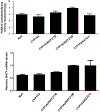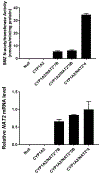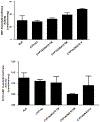Acetylation of putative arylamine and alkylaniline carcinogens in immortalized human fibroblasts transfected with rapid and slow acetylator N-acetyltransferase 2 haplotypes
- PMID: 33136180
- PMCID: PMC7855884
- DOI: 10.1007/s00204-020-02901-4
Acetylation of putative arylamine and alkylaniline carcinogens in immortalized human fibroblasts transfected with rapid and slow acetylator N-acetyltransferase 2 haplotypes
Abstract
Exposure to alkylanilines found in tobacco smoke and indoor air is associated with risk of bladder cancer. Genetic factors significantly influence the metabolism of arylamine carcinogens and the toxicological outcomes that result from exposure. We utilized nucleotide excision repair (NER)-deficient immortalized human fibroblasts to examine the effects of human N-acetyltransferase 1 (NAT1), CYP1A2, and common rapid (NAT2*4) and slow (NAT2*5B or NAT2*7B) acetylator human N-acetyltransferase 2 (NAT2) haplotypes on environmental arylamine and alkylaniline metabolism. We constructed SV40-transformed human fibroblast cells that stably express human NAT2 alleles (NAT2*4, NAT2*5B, or NAT2*7B) and human CYP1A2. Human NAT1 and NAT2 apparent kinetic constants were determined following recombinant expression of human NAT1 and NAT2 in yeast for the arylamines benzidine, 4-aminobiphenyl (ABP), and 2-aminofluorene (2-AF), and the alkylanilines 2,5-dimethylaniline (DMA), 3,4-DMA, 3,5-DMA, 2-6-DMA, and 3-ethylaniline (EA) compared with those of the prototype NAT1-selective substrate p-aminobenzoic acid and NAT2-selective substrate sulfamethazine. Benzidine, 3,4-DMA, and 2-AF were preferential human NAT1 substrates, while 3,5-DMA, 2,5-DMA, 3-EA, and ABP were preferential human NAT2 substrates. Neither recombinant human NAT1 or NAT2 catalyzed the N-acetylation of 2,6-DMA. Among the alkylanilines, N-acetylation of 3,5-DMA was substantially higher in human fibroblasts stably expressing NAT2*4 versus NAT2*5B and NAT2*7B. The results provide important insight into the role of the NAT2 acetylator polymorphism (in the presence of competing NAT1 and CYP1A2-catalyzed N-acetylation and N-hydroxylation) on the metabolism of putative alkyaniline carcinogens. The N-acetylation of two alkylanilines associated with urinary bladder cancer (3-EA and 3,5-DMA) was modified by NAT2 acetylator polymorphism.
Keywords: 3,5-dimethylaniline; 3-ethylaniline; Alkylanilines; Arylamine N-acetyltransferase 2; N-acetylation polymorphism.
Conflict of interest statement
Conflict of Interest Declaration
The authors declare that they have no conflict of interest.
Figures






Similar articles
-
Metabolic activation and deactivation of arylamine carcinogens by recombinant human NAT1 and polymorphic NAT2 acetyltransferases.Carcinogenesis. 1993 Aug;14(8):1633-8. doi: 10.1093/carcin/14.8.1633. Carcinogenesis. 1993. PMID: 8353847
-
Metabolic activation of N-hydroxy-2-aminofluorene and N-hydroxy-2-acetylaminofluorene by monomorphic N-acetyltransferase (NAT1) and polymorphic N-acetyltransferase (NAT2) in colon cytosols of Syrian hamsters congenic at the NAT2 locus.Cancer Res. 1993 Feb 1;53(3):509-14. Cancer Res. 1993. PMID: 8425184
-
4-Aminobiphenyl downregulation of NAT2 acetylator genotype-dependent N- and O-acetylation of aromatic and heterocyclic amine carcinogens in primary mammary epithelial cell cultures from rapid and slow acetylator rats.Toxicol Sci. 2009 Jan;107(1):293-7. doi: 10.1093/toxsci/kfn216. Epub 2008 Oct 8. Toxicol Sci. 2009. PMID: 18842621 Free PMC article.
-
Molecular genetics and function of NAT1 and NAT2: role in aromatic amine metabolism and carcinogenesis.Mutat Res. 2002 Sep 30;506-507:65-77. doi: 10.1016/s0027-5107(02)00153-7. Mutat Res. 2002. PMID: 12351146 Review.
-
Molecular genetics and epidemiology of the NAT1 and NAT2 acetylation polymorphisms.Cancer Epidemiol Biomarkers Prev. 2000 Jan;9(1):29-42. Cancer Epidemiol Biomarkers Prev. 2000. PMID: 10667461 Review.
Cited by
-
Hexavalent chromium increases the metabolism and genotoxicity of aromatic amine carcinogens 4-aminobiphenyl and β-naphthylamine in immortalized human lung epithelial cells.Toxicol Appl Pharmacol. 2022 Aug 15;449:116095. doi: 10.1016/j.taap.2022.116095. Epub 2022 Jun 2. Toxicol Appl Pharmacol. 2022. PMID: 35662664 Free PMC article.
-
Expression of arylamine N-acetyltransferase 2 activity in immortalized human bronchial epithelial cells.Toxicol Appl Pharmacol. 2022 May 1;442:115993. doi: 10.1016/j.taap.2022.115993. Epub 2022 Mar 27. Toxicol Appl Pharmacol. 2022. PMID: 35353990 Free PMC article.
-
Bioactivation, Mutagenicity, DNA Damage, and Oxidative Stress Induced by 3,4-Dimethylaniline.Biomolecules. 2024 Dec 7;14(12):1562. doi: 10.3390/biom14121562. Biomolecules. 2024. PMID: 39766269 Free PMC article.
-
Acetyl coenzyme A kinetic studies on N-acetylation of environmental carcinogens by human N-acetyltransferase 1 and its NAT1*14B variant.Front Pharmacol. 2022 Oct 28;13:931323. doi: 10.3389/fphar.2022.931323. eCollection 2022. Front Pharmacol. 2022. PMID: 36386142 Free PMC article.
-
Effects of dose and human N-acetyltransferase 1 genetic polymorphism in benzidine metabolism and genotoxicity.Arch Toxicol. 2023 Jun;97(6):1765-1772. doi: 10.1007/s00204-023-03497-1. Epub 2023 Apr 25. Arch Toxicol. 2023. PMID: 37097310 Free PMC article.
References
-
- Baldauf KJ, Salazar-González RA, Doll MA, Pierce WM Jr., States JC, Hein DW (2020) Role of Human N-Acetyltransferase 2 Genetic Polymorphism on Aromatic Amine Carcinogen-Induced DNA Damage and Mutagenicity in a Chinese Hamster Ovary Cell Mutation Assay. Environ Mol Mutagen 61(2):235–245 doi:10.1002/em.22331 - DOI - PMC - PubMed
-
- Bendaly J, Zhao S, Neale JR, et al. (2007) 2-Amino-3,8-dimethylimidazo-[4,5-f]quinoxaline-induced DNA adduct formation and mutagenesis in DNA repair-deficient Chinese hamster ovary cells expressing human cytochrome P4501A1 and rapid or slow acetylator N-acetyltransferase 2. Cancer Epidemiol Biomarkers Prev 16(7):1503–9 doi:16/7/1503 10.1158/1055-9965.EPI-07-0305 - DOI - PMC - PubMed
Publication types
MeSH terms
Substances
Grants and funding
LinkOut - more resources
Full Text Sources
Research Materials

